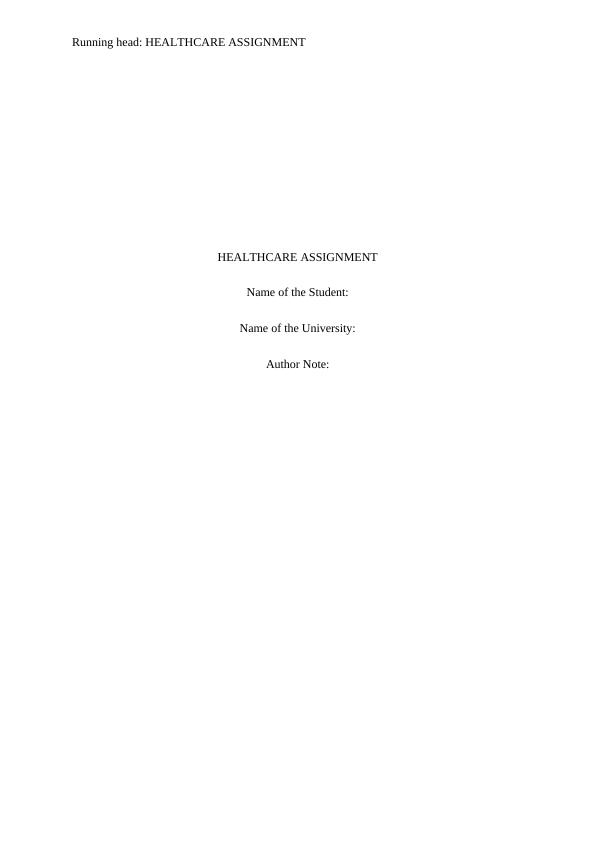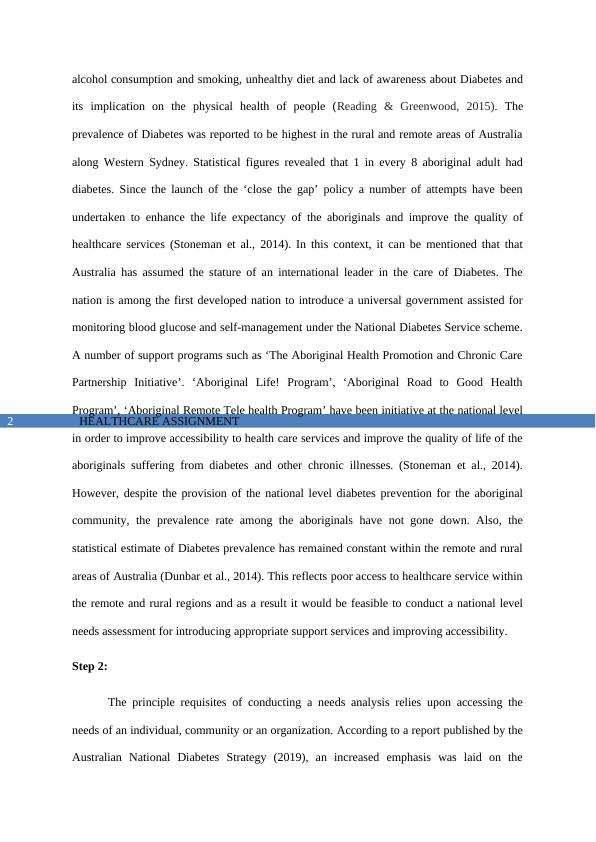Controlling Diabetes among Aboriginal and Torres Islander Population
Added on 2023-01-10
9 Pages2143 Words29 Views
Running head: HEALTHCARE ASSIGNMENT
HEALTHCARE ASSIGNMENT
Name of the Student:
Name of the University:
Author Note:
HEALTHCARE ASSIGNMENT
Name of the Student:
Name of the University:
Author Note:

HEALTHCARE ASSIGNMENT1
Introduction:
According to Gale et al. (2013), the Needs analysis approach can be defined as the
procedure by virtue of which the human needs for a specific product is analysed. As stated by
Gale et al. (2013), the Needs Analysis tool serves as an analytical tool that helps in evaluating
the marketability of a service to the consumers. It should be noted here that the application of
needs analysis has not remained restricted to the domain of business and marketing but also
finds application in the domain of healthcare. This paper intends to evaluate the existing
national and state legislations that are available in relation to controlling Diabetes among the
Aboriginal and Torres Islander population.
Step 1:
According to Harris et al. (2013), it has been estimated that approximately, 1.2
million Australians that make up 6% of the Australian population suffer from Diabetes.
Further, as suggested by the statistics published by the Australian Bureau of Statistics (2019),
it was stated that the most common form of Diabetes that affected Australians included Type
I Diabetes, Type II Diabetes and Gestational Diabetes. In addition to this, a research study
published by Stoneman et al. (2014), mentioned that the indigenous population base of
Australia was three times more likely to suffer from Diabetes than the non-indigenous
population base of Australia. In addition to this, aboriginal women were twice more likely to
develop gestational diabetes than non-indigenous women. Further, research studies also
revealed that aboriginal children were 8 time more likely to develop diabetes than non-
indigenous Australian children. As stated by Australian Bureau of Statistics (2019), the
mortality rate due to Diabetes was reported to be six times higher in aboriginal and Torres
Islander community than in the non-indigenous Australians. The reported factors for the high
prevalence rate was found to be a sedentary lifestyle, lack of physical exercise, increased
Introduction:
According to Gale et al. (2013), the Needs analysis approach can be defined as the
procedure by virtue of which the human needs for a specific product is analysed. As stated by
Gale et al. (2013), the Needs Analysis tool serves as an analytical tool that helps in evaluating
the marketability of a service to the consumers. It should be noted here that the application of
needs analysis has not remained restricted to the domain of business and marketing but also
finds application in the domain of healthcare. This paper intends to evaluate the existing
national and state legislations that are available in relation to controlling Diabetes among the
Aboriginal and Torres Islander population.
Step 1:
According to Harris et al. (2013), it has been estimated that approximately, 1.2
million Australians that make up 6% of the Australian population suffer from Diabetes.
Further, as suggested by the statistics published by the Australian Bureau of Statistics (2019),
it was stated that the most common form of Diabetes that affected Australians included Type
I Diabetes, Type II Diabetes and Gestational Diabetes. In addition to this, a research study
published by Stoneman et al. (2014), mentioned that the indigenous population base of
Australia was three times more likely to suffer from Diabetes than the non-indigenous
population base of Australia. In addition to this, aboriginal women were twice more likely to
develop gestational diabetes than non-indigenous women. Further, research studies also
revealed that aboriginal children were 8 time more likely to develop diabetes than non-
indigenous Australian children. As stated by Australian Bureau of Statistics (2019), the
mortality rate due to Diabetes was reported to be six times higher in aboriginal and Torres
Islander community than in the non-indigenous Australians. The reported factors for the high
prevalence rate was found to be a sedentary lifestyle, lack of physical exercise, increased

HEALTHCARE ASSIGNMENT2
alcohol consumption and smoking, unhealthy diet and lack of awareness about Diabetes and
its implication on the physical health of people (Reading & Greenwood, 2015). The
prevalence of Diabetes was reported to be highest in the rural and remote areas of Australia
along Western Sydney. Statistical figures revealed that 1 in every 8 aboriginal adult had
diabetes. Since the launch of the ‘close the gap’ policy a number of attempts have been
undertaken to enhance the life expectancy of the aboriginals and improve the quality of
healthcare services (Stoneman et al., 2014). In this context, it can be mentioned that that
Australia has assumed the stature of an international leader in the care of Diabetes. The
nation is among the first developed nation to introduce a universal government assisted for
monitoring blood glucose and self-management under the National Diabetes Service scheme.
A number of support programs such as ‘The Aboriginal Health Promotion and Chronic Care
Partnership Initiative’. ‘Aboriginal Life! Program’, ‘Aboriginal Road to Good Health
Program’, ‘Aboriginal Remote Tele health Program’ have been initiative at the national level
in order to improve accessibility to health care services and improve the quality of life of the
aboriginals suffering from diabetes and other chronic illnesses. (Stoneman et al., 2014).
However, despite the provision of the national level diabetes prevention for the aboriginal
community, the prevalence rate among the aboriginals have not gone down. Also, the
statistical estimate of Diabetes prevalence has remained constant within the remote and rural
areas of Australia (Dunbar et al., 2014). This reflects poor access to healthcare service within
the remote and rural regions and as a result it would be feasible to conduct a national level
needs assessment for introducing appropriate support services and improving accessibility.
Step 2:
The principle requisites of conducting a needs analysis relies upon accessing the
needs of an individual, community or an organization. According to a report published by the
Australian National Diabetes Strategy (2019), an increased emphasis was laid on the
alcohol consumption and smoking, unhealthy diet and lack of awareness about Diabetes and
its implication on the physical health of people (Reading & Greenwood, 2015). The
prevalence of Diabetes was reported to be highest in the rural and remote areas of Australia
along Western Sydney. Statistical figures revealed that 1 in every 8 aboriginal adult had
diabetes. Since the launch of the ‘close the gap’ policy a number of attempts have been
undertaken to enhance the life expectancy of the aboriginals and improve the quality of
healthcare services (Stoneman et al., 2014). In this context, it can be mentioned that that
Australia has assumed the stature of an international leader in the care of Diabetes. The
nation is among the first developed nation to introduce a universal government assisted for
monitoring blood glucose and self-management under the National Diabetes Service scheme.
A number of support programs such as ‘The Aboriginal Health Promotion and Chronic Care
Partnership Initiative’. ‘Aboriginal Life! Program’, ‘Aboriginal Road to Good Health
Program’, ‘Aboriginal Remote Tele health Program’ have been initiative at the national level
in order to improve accessibility to health care services and improve the quality of life of the
aboriginals suffering from diabetes and other chronic illnesses. (Stoneman et al., 2014).
However, despite the provision of the national level diabetes prevention for the aboriginal
community, the prevalence rate among the aboriginals have not gone down. Also, the
statistical estimate of Diabetes prevalence has remained constant within the remote and rural
areas of Australia (Dunbar et al., 2014). This reflects poor access to healthcare service within
the remote and rural regions and as a result it would be feasible to conduct a national level
needs assessment for introducing appropriate support services and improving accessibility.
Step 2:
The principle requisites of conducting a needs analysis relies upon accessing the
needs of an individual, community or an organization. According to a report published by the
Australian National Diabetes Strategy (2019), an increased emphasis was laid on the

End of preview
Want to access all the pages? Upload your documents or become a member.
Related Documents
Social Determinants of Health (SDOH) in Australialg...
|16
|3844
|153
Indigenous Health and Wellbeing Essay 2022lg...
|9
|2222
|19
Introduction Australia’s Governments has been facing thelg...
|7
|1972
|1
The sociological imagination templatelg...
|11
|2654
|47
Diabetes among Aboriginal and Torres Strait Islander people in Australialg...
|8
|2145
|210
The health care system in Australialg...
|9
|1438
|25